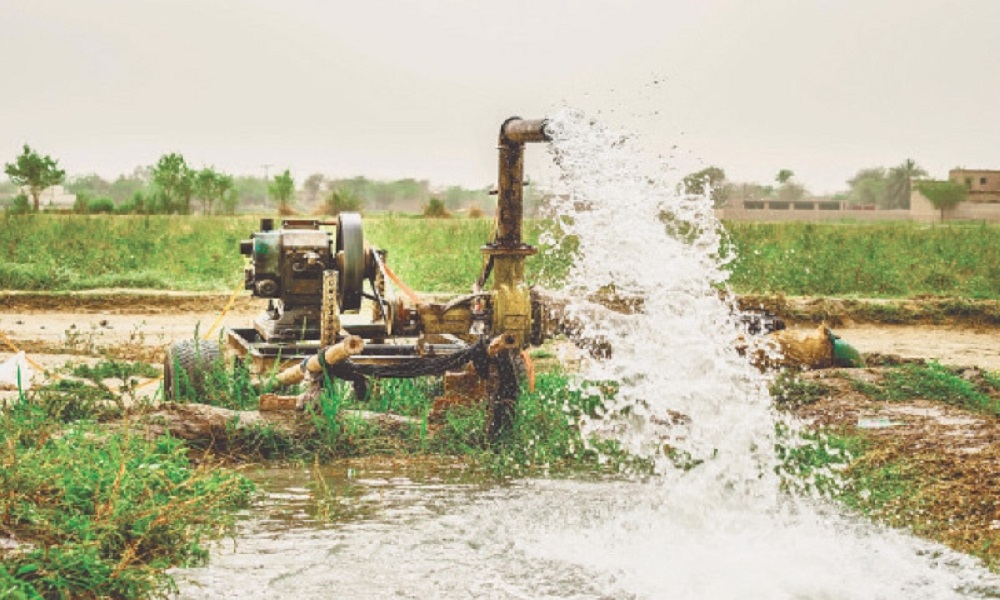In the face of rapidly changing climatic conditions, the agricultural sector in Pakistan, particularly in Sindh, finds itself grappling with a myriad of challenges. With rising temperatures, erratic rainfall patterns, and prolonged droughts wreaking havoc, crop yields have been severely impacted, and water availability has become increasingly scarce.
The current scenario presents a substantial threat to the sustenance of food and the means of livelihood. Nevertheless, amidst these overwhelming challenges, there arises a ray of optimism as farmers delve into various techniques and methods to enhance crop water productivity.
Pakistan’s crop water productivity falls behind the global average, with wheat and rice crops exhibiting lower yields per unit of water. The current water productivity of wheat stands at 0.76 kilograms per cubic meter of water, 24 per cent less than the global average of 1kg per cubic meter.
Similarly, the water productivity of rice crops measures 0.45kg per cubic meter, approximately 55pc below the average value for rice in Asia. Nevertheless, farmers are actively seeking ways to tackle these challenges and enhance crop water productivity.
Revolutionising traditional farming techniques is crucial in mitigating the risks posed by climate change. By embracing sustainable and efficient hi-tech irrigation methods like drip irrigation, precision sprinklers, and moisture sensors, farmers can deliver water precisely to the plant roots, minimising wastage and optimising water usage.
In order to sustain agricultural productivity in Sindh, it is crucial to adopt crop varieties that are climate-resilient, drought-tolerant, and heat-resistant. This approach provides a necessary safeguard against the challenging environmental conditions that farmers in the region face. By utilising such crop varieties, farmers can ensure that their crops are better equipped to withstand the adverse effects of climate change, leading to more consistent and reliable yields.
Adopting soil conservation practices, such as zero tillage, mulching, and cover cropping, aids in retaining soil moisture and improving water-holding capacity. Farmers in rice-growing districts of Sindh have already embraced zero tillage techniques for growing wheat crops, effectively reducing soil erosion and enhancing soil health.
Such measures ensure the effective utilisation of available water resources in the face of climate variability. Improved water management techniques are also essential for enhancing crop water productivity.
Using weather forecasts and evapotranspiration data, efficient water scheduling allows farmers to optimise irrigation timing and quantities, ensuring crops receive adequate water without excessive usage.
Furthermore, integrated water resource management, including rainwater harvesting and water storage infrastructure, contributes to water availability during dry spells.
Despite the potential benefits of micro-irrigation systems, including enhanced plant growth, crop yield, quality, and reduced fertiliser and pesticide use, adoption rates in Sindh remain low. Challenges such as high initial system installation costs, technical expertise requirements, clogging of emitters, water distribution limitations, energy requirements, development of soil salinity patches and difficulty in land tillage have contributed to the hesitancy in adopting these technologies. Addressing the root causes behind this non-adoption is crucial for promoting sustainable practices.
Indigenous irrigation methods, rooted in traditional knowledge and practices passed down through generations, offer alternative approaches. These methods often utilise locally available and affordable materials, reducing the financial burden on farmers.
The furrow irrigation method, for example, can save up to 30pc of irrigation water compared to flood irrigation, and further improvements can raise the savings to 40pc or even 50pc. The raised bed irrigation method optimises water use and improves crop health and yield. By leveraging such indigenous techniques, farmers can enhance irrigation efficiency.
Although Australia has low per capita water availability, even then, about 58pc of the land is irrigated through surface irrigation methods.
Enhancing crop water productivity in Sindh requires collective efforts to adapt to climate change and promote sustainable agriculture.
Minimising water wastage, reducing reliance on unsustainable practices and maximising productivity are key factors in building resilience, securing livelihoods and ensuring regional food security.
Raising awareness among farmers about the impacts of climate change and the importance of sustainable agricultural practices is essential.
Training programmes, workshops, and knowledge-sharing platforms empower farmers with the tools, skills, and knowledge required to adapt effectively to the changing climate.
The journey towards adapting to the effects of climate change and improving crop water productivity demands transformative measures. By embracing innovative techniques, sustainable practices, and suitable technologies, the agricultural sector in Sindh can achieve resilience, ensuring the continuous production of crops while protecting the environment and preserving natural resources.
It is a collective responsibility to forge ahead on this path, safeguarding the future of agriculture in Pakistan.
Source : Down

